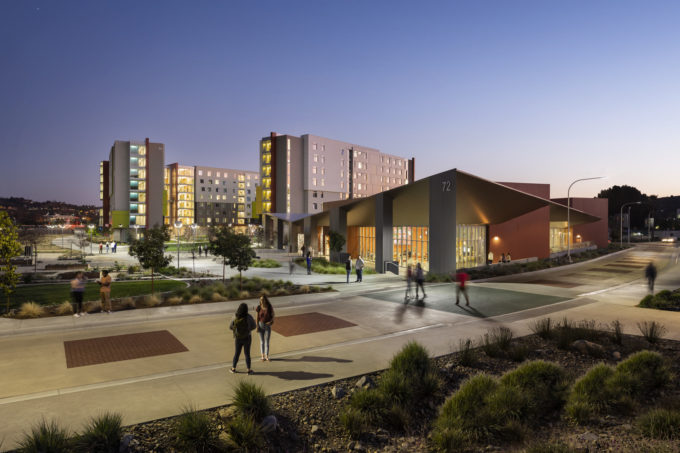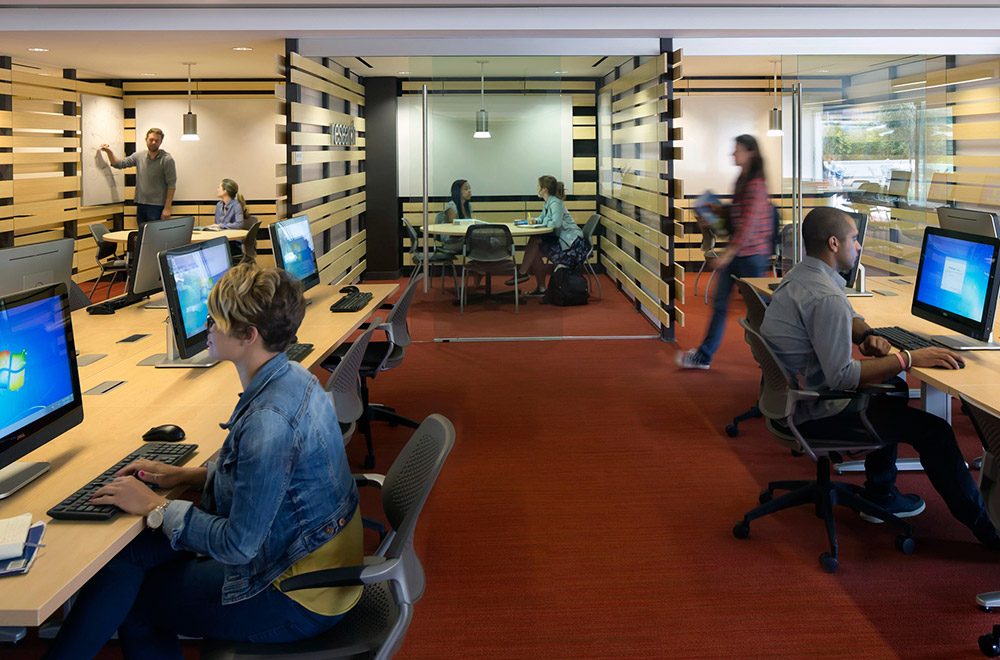We live in a world with a finite amount of land. There are about eight parking stalls in the United States for every registered vehicle in the United States. Surface parking lots alone cover more than five percent of all urban land in the country; and across Los Angeles County, surface lots occupy an astonishing 101 square miles—more than four times the size of New York City.
By the end of the 2020-21 school year, The California State University system had about 170,000 usable parking spaces, or over 1,000 acres of parking. The need for parking on California’s campuses is growing while cars and their parking lots take up a lot of valuable land.
Many California colleges began as commuter schools in small neighborhoods in the 1950s and 60s. Founded as commuter campuses when land was plentiful and affordable, an abundance of surface parking lots and car-friendly campuses created a perceived sense of convenience. However, this decades-old campus planning model has caused numerous long-lasting damaging issues around safety, the student experience, and land use. As these schools grow with their neighborhoods, traffic jams on and around campus, safety conflicts, parking priorities, and car smells and noises create a less than desirable campus experience. Administrators also worry that a student who drives to class may leave campus in between classes and not return for the day, negatively impacting their odds for success as well as their experience.
Most commuters to CSU’s and community colleges live within 10 miles of campus. However, the public transportation system in California suffers from two main issues, perception and reality, both of which make taking the bus less desirable. For some students, a 10-mile bus ride can take an hour. In comparison, that same student would only spend about 20 minutes driving. While public transit is available, it’s not always the most efficient, so the car is still king in California.
The four-year graduation rates in the CSUs have made a steady positive climb in the last 10 years, and even better when we lower the bar to six years in school. However, lowering the bar to six years means academic seats on campus are impacted longer by the same student, thus clogging up space for others while the wait list grows. We need strategies to facilitate student success, faster.
How can we rethink parking as we expand campuses, and how can that impact student success? As campuses grow and transition from a commuter model to a residential model, and administrators look to add new classrooms, libraries, or dorms; available land is at a premium and parking lots occupy valuable space. So, how can campus planners and designers balance the need for transportation with the havoc cars create for the campus?

Administrators and planners can consider several ideas to support their students and plan for a growing campus. These ideas are generally not free or easy, and though they may seem disconnected from one another, the eco system that fosters student success takes a broad, coordinated approach by many entities.
Calculate full build-out.
Determine your campus’ future demand based on your master planned full build-out and maximum census. This will give you a realistic picture of your transportation needs, not just parking. Consider all public transit, campus shuttles, and links to the surrounding community to where your students live to determine the appropriate number of parking spaces.
Rethink parking lots and structures.
If the demand is validated, build garages on the perimeter of campus and remove centrally located parking. Don’t build a garage in the middle of your campus. This eliminates the daily influx of traffic to the campus core and improves the campus experience and safety for all.
Remove surface lots from the central campus and convert them into green spaces. These spaces between your buildings are what make or break a beautiful campus. With careful consideration, schools can convert a centrally located garage into student housing or other uses, thus transforming the institution from a commuter school to a residential campus.
Raise the price.
Consider charging more for parking. Find a point that seems uncomfortable, then raise it. Parking on your land should be considered a luxury, not a right. By raising the price of parking, students, faculty, and staff will eventually consider alternative transportation options.
Consider not allowing freshman parking on campus, or don’t sell parking permits to those living within two miles of campus. Students who live closer to campus may be able to take a scooter, bike, or local transit to keep their car off your campus. 80 percent success here is a victory but is dependent on creating an environment where students don’t need a car.
Make more reasons to stay on campus.
Create more student housing, augment the social infrastructure with dining, healthcare, security, basic retail, and indoor and outdoor recreation spaces, and extend the hours of student success spaces and other student services. This will keep students on campus and decrease their reliance on cars.
Connect with public transportation.
Connect your campus loops to local and regional transit systems. Offer shuttles between campus and local transit hubs. Collaborate with local transit for free or reduced fees for students and faculty/staff. Many institutions such as LACCD have agreements in place with local transit systems to allow enrolled students to ride for free. Provide shuttles from off-campus student housing to campus.
Go on a road diet.
Take a student-centric approach to your precious land. Put your campus on a road diet, especially closer to the center. If internal roads need to remain, flush curb them with pavers to remove miles of raised curbs that are trip hazards. Remove small internal legacy parking lots, and the road to get there.
For the remaining roads, they don’t need to look like roads. Be a proponent of flush curbing, table-top crosswalks, and a variety of colors and materials for paving. Think about student safety first.
Create a bike-friendly environment.
The last mile can be the hardest to figure out. Implement your own “yellow bike” program and group the depots at transit hubs. Provide more safe locations and corrals for students to park their bike. Create well marked, dedicated bike lanes, and work with your local municipality to extend those lanes into the community.
Plan for tomorrow, now.
Coordinate and align your campus master plans, transportation plans, sustainability plans, and housing master plans. The biggest confluence between these efforts is parking, and they cannot be considered in isolation.
Create a clear and coordinated multi-modal system on campus that consists of a network that organizes cars, buses, bikes, electric scooters, skateboards, and pedestrians. Transportation master plans provide strategies that reduce trips to campus, not how to manage more trips. Partner with your regional bus lines, in both schedule and fees reductions for students, faculty, and staff.
More housing = less cars.
Re-evaluate your parking needs before and after each new project. If you add 400 beds, then you can eliminate 350 parking spaces. Short term, that’s well over an acre of open space you just created for your students, and long term you just create a new building site, maybe for more housing. Amazon is not delivering land to anyone overnight. Make your own!
Be a leader.
A prospective student will decide in their first 10 minutes on campus whether to consider it or not. Where does your campus tour take them? Think about it. This is based mostly on aesthetics. They are looking ahead, as should you.
Change is hard, and leaders make big changes. These ideas can be painful, take a while to implement, and may not win you any popularity contests in the short term. The long-term benefits for the campus outweigh these impacts. Consider that your student body turns over about every five years, and your new students don’t care about the good old’ days.
